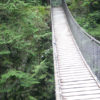V ermillion Lakes is a series of three lakes which are part of a riparian wetland located at the foot of Mount Norquay across Trans-Canada Highway 1 just west of the exit to the town of Banff.
Scenic Vermillion Lakes in Banff National Park

There are two ways to view Vermillion Lakes. One of them is an observation area with its own parking lot, which is accessed from the eastbound lanes of Trans-Canada Highway 1 just west of the exit for Banff and Mount Norquay. This is a good place to get an overall view of Vermillion Lakes — especially if you are pressed for time and are on your way east on Trans-Canada Highway 1, as you can spend as few as ten minutes here…

…although the view westbound along the highway is quite scenic, with Mount Bourgeau looming in the distance.

Mountains surround the Vermillion Lakes area…

…including the unmistakable Mount Rundle, which appears majestic up close as well as from far away with its towering cliffs.

Mount Bourgeau was named after a botanist named Eugène Bourgeau, who explored these mountains as part of the Palliser Expedition between 1857 and 1860.

Mount Rundle was named after a Methodist missionary known as Reverend Robert Rundle.

As is indicative in different national and provincial parks in Canada with mountains, signs identify the names of the mountains to which they point.

The other way to view the Vermillion Lakes is by driving on Vermillion Lakes Drive, which lazily winds its way along the edges of the lakes, paralleling Trans-Canada Highway 1 — but vehicles travel at significantly slower speeds.

Public service message: do not succumb to pier pressure — no matter how tempting.

Significant breaks in the clouds — revealing blue skies — lasted only briefly during an otherwise overcast evening.

The peak of Mount Bourgeau on the left is enshrouded by clouds; while Mount Brett and Pilot Mountain — which also have snow on them — are shown in the background on the right.

The massive limestone wall of Mount Rundle stretches 12 kilometers southeast to the town of Canmore.

Some of the mountains of the Sundance Range are featured at the Vermillion Lakes.

The national park system of Canada was born at the foot of Sulfur Mountain.

There are plenty of places along Vermillion Lakes Drive where you can stop and sit comfortably on a bench to admire — and be inspired by — the idyllic scenery. This view features Tunnel Mountain just left of the center as it is dwarfed by Mount Rundle.
Summary
As one of the most photographed areas in the Rocky Mountains of Canada, Vermillion Lakes is definitely a beautiful spot to visit. It is located conveniently north and west of Banff right off of the exit from Trans-Canada Highway 1. There is no admission fee to visit; and you can stay as long as you like.
I visited Vermillion Lakes when the skies were overcast during the evening, which did not exactly result in the best photographs I could have ever taken. I was hoping that the sun would be visible setting in the west to give more dramatic lighting effects; but the clouds obscured it. Although you can visit Vermillion Lakes anytime and marvel at the spectacular scenery at your convenience, try arriving either at dawn or dusk — or just before or after dawn or dusk — for best results in terms of lighting.
Depending on the time of year when you visit Vermillion Lakes, you can view Aurora Borealis, which is also known as the Northern Lights — if you are fortunate enough — typically during winter.
All photographs ©2017 by Brian Cohen.

